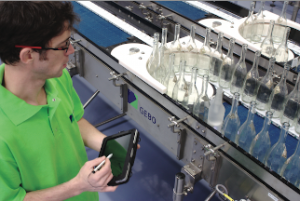Scratches, abrasions, deformations and breakages of containers on packaging lines have negative consequences for line efficiency, cost efficiency and/or brand image. So Gebo has added two new options to its range of audits, “shocks “pressure”, that detect, locate, and measure the critical points on the packaging line.

When these are incorporated into Gebo's EITTM (Efficiency Improvement Tool) solution, they also analyse problems, give recommendations for improvement and implement changes that are identified as being necessary.
Natural variations in temperature and humidity, condensation, deficient servicing, maintenance and cleaning of production tools, use of primary packaging that is lighter, and optimisation or elimination of secondary packaging can all weaken the containers travelling along the packaging line. Shocks that are too violent or repeated too often and/or untimely pressures at certain points of the line can then affect them, in particular glass and PET bottles, tin cans, and glass jars. Beverage containers are especially vulnerable.
Depending on the place at which the incident occurs, a bottle that breaks causes the machine to stop or the entire line to be brought to a standstill, requires the debris to be removed and the portion in question to be cleaned. This can cause product loss or wastage that can be as extensive as an entire pallet, depending on the time at which the breakage is discovered. If not detected, a scratched glass bottle, a deformed can, or an abraded label downgrade the brand and product image at retail.
Gebo understood that a situation can be improved only if it has been accurately measured. So its shocks audit and/or pressure audit
Measure, in situ, the shocks and/or the pressures to which the containers are subjected, quantify the consequences of the damage suffered, compare the results with reference values, locate the causes, establish diagnostics of the solutions propose a corrective action plan.
Added to the range of packaging line audit solutions proposed by Gebo, the shocks and pressure audits study all of the conveying and accumulation phases, and also what occurs inside the machines such as fillers, cappers, case packers, bundlers, wrappers, or palletisers/depalletisers. The shocks audit measures the shocks and impacts, while the pressure audit detects the abnormal pressure zones and the line regulation problems, current market trends being to limit pressures to as low as possible (tending towards 0 pressure) and to reduce the accumulation zones.
The technology behind them combines a sensor protected by a container with software installed on a tablet or on a laptop computer, recording the data in real time:
1. Shock sensor: accelerometers make it possible to compute deceleration on 3 axes. It is insert in a hard plastic (acetal) container of the same shape as the packaging handled by the line;
2. Pressure sensor: a cylinder incorporating 500 pressure measurement points is distributed over the outside of the container.
Eric Hache, asset performance manager, explained, “Our first deliverable is an action plan for reducing the shocks and the pressure, and for reducing the damage caused to the container. Our expertise in packaging machines, conveyors and engineering then enables us quite naturally to propose implementation of the plan to our clients, regardless of whether or not their lines and machines were supplied by Gebo Cermex. We intervene in particular on adjusting the automated control and regulation of the line, on improving the automated control or the mechanics of the interface and transfer zones, on adjusting or changing the machine infeeds, and, where necessary, on re- engineering a portion of the line.”
In 2015, the shocks and pressure audits are also being enriched with new features, including automatic geolocation of critical points. These audits will then join the EITTM platform as new modules in Gebo’s overall solution for analysing and improving productivity. It will then be possible to compile the data collected in the platform and to cross-correlate it with the data processed by other modules.





